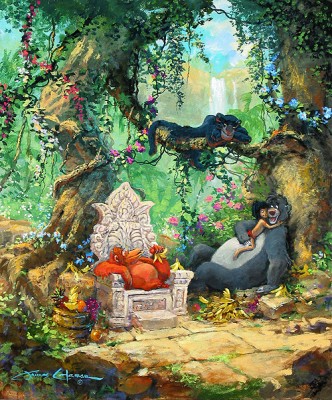The Jungle Book vs. The Jungle Books
Disney’s The Jungle Book is inspired by Rudyard Kipling’s novel The Jungle Books
– specifically, the stories of Mowgli, a young boy raised by animals
who must one day return to the man village. For anyone unfamiliar with
the non-cake-related Mr. Kipling, he was considered to be one of
England’s finest writers and poets during the 19th and early 20th
Century, and had strong connections to India, since he was both born
there and worked there periodically.
He wrote eight stories about the aforementioned “man-cub” in his novel- Mowgli’s Brothers, Kaa’s Hunting, Tiger! Tiger! How Fear Came, Letting in the Jungle, The King’s Ankus, Red Dog and The Spring Running
– and Disney pinched elements of each when putting their own story
together. Given that relations between England and India had moved on
somewhat since the book was written in 1894-5 (the film was released in
1967), you would expect Disney to have made some tweaks to make things
more politically correct or family friendly. This is indeed the case,
but the two versions differ in so many respects it’s not really possible
to compare the different chapters side by side. Instead, I will compare
the common events and characters in the film with those in the book, so
forgive me if this post ends up Tarantino-esque – i.e. if the story is
ordered arse-about-face (don’t worry, no guns this time!).
The Main Characters
Disney version

Mowgli
was found abandoned as a baby, and was raised in the jungle by wolves.
Like most smart-alecky ten year-olds, he gives as good as he gets from
the other animals, and is pretty much fearless, even when faced with
man-eating tigers and snakes. The only time he shows real fear is when
the “man village” is mentioned, as he has no desire to leave the jungle
where he grew up. He is an endless source of amusement for the other
animals, due to his gangly form and his failure to do much of anything
to survive in the jungle.

He
is also an endless source of exasperation for Bagheera, the panther,
Mowgli’s friend and self-appointed guardian, who has taken it upon
himself to take the man-cub back to where he belongs. Bagheera is wise
but also short on patience it seems, although he doesn’t unleash his
claws or use his panther-power much at all. He serves as the voice of
reason in the jungle, and even when he loses patience with Mowgli and
walks away, he returns the instant that something seems amiss.

Mowgli’s
best friend is Baloo the bear, who is also naively confident about
survival in the wild. Baloo spends his days eating bugs, fruit and
scratching himself with trees and rocks, and taking life at a slow pace
while being a slave to the beat. Despite his size, Baloo is rather
useless at protecting himself or Mowgli, and ends up running to Bagheera
for counsel. Although his heart’s in the right place, he’s basically a
ten year-old child in the form of an adult bear.
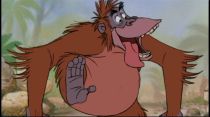
King
Louie is an orangutan who apparently wandered out of Borneo and
proclaimed himself “king of the swingers” in India. He wants to become a
human, and rather than learning to talk or wearing clothes, he
naturally thinks that fire is the answer. He therefore turns to (or
rather “captures”) Mowgli to learn this secret.
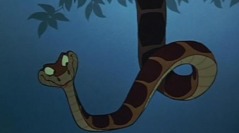
Another
character intent on capturing Mowgli is Kaa, the python, but the only
secret he seeks is the key to a full stomach. He has the creepy habit
of hypnotising his victims before devouring them alive (at least he puts
them to sleep first I suppose), and has thus become nightmare fuel for
generations of children (myself included), especially since he has the
same voice actor as the cute and cuddly Winnie the Pooh.

Finally,
we have Shere Khan, the main antagonist of the film. A man-eating
tiger, he seeks to kill Mowgli while he’s young and helpless, rather
than later in life when he is an adult armed with a gun. Given that
Shere Khan is an endangered species, you can’t really blame him for
being retroactive, but everyone is afraid of him, and he will not stop
in his quest until he has killed the man-cub. He is only spoken about
for the first half of the film, so by the time he appears on screen,
there is a suitable aura of fear and badassery surrounding him.
Kipling version

Other
than the fact his name is pronounced “Mow”-(as in “now”)-gli, one of
the first things you’ll notice is that Kipling’s protagonist is
stark-bollock-naked throughout the book, and expresses disdain at having
to wear a loin cloth when he goes to the man village. He is as fearless
as Disney’s Mowgli (if not more), and is actually very cunning and fits
seamlessly into the jungle environment. His gangly figure earns him the
name of “Mowgli the Frog”, but despite this he can hunt, track and kill
just as well as the other predators. His only limitation is that his
sense of smell is not quite as good as his companions’, but other than
this, he bests many of them in strength and intelligence.

Bagheera
is still Mowgli’s wise companion, but their relationship is much more
equal, and he arguably has more balls and a background in this version.
He was born in a cage in the king’s palace at Oodeypore, and still has
the mark of the human collar he wore. He managed to escape thanks to a
broken lock, but he has kept this secret from all but Mowgli. He is
known as a formidable hunter, and is actually even more feared than
Shere Khan. Sadly, he’s not the only character Disney did a number on.
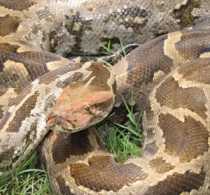
Poor old Kaa.
Far from being nightmare fuel, Kaa the
rock python is one of Mowgli’s wisest and most helpful companions, and
he saves his life on more than one occasion. He doesn’t have any
psychedelic eyeball-thing going on, but he does have a strange dance he
uses to stun his prey, namely the chattering monkeys.
There is no King Louie in this version, but there is a community of monkeys known as the bandar-log,
who have no leader and act like a collection of children with ADHD.
They live in ruins known as the Cold Lairs, and they capture Mowgli
because they also seek his extensive human knowledge.
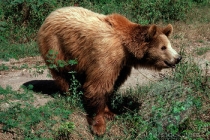
Instead
of teaching Mowgli fun things like the bare necessities of eating and
sleeping, Baloo in the book teaches Mowgli about the Laws of the Jungle,
and frequently smacks him upside the head if he gets anything wrong.
This happens so frequently that even Bagheera has to step in and ask him
to tone down the pastoral violence. Despite this, Baloo is just as
devoted to Mowgli’s safety as he is in the film, and helps rescue him
from the monkeys.
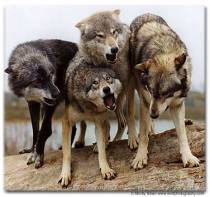
The
wolf pack has a much stronger role in the book than in the film, as
several of the members remain with Mowgli throughout his life in the
jungle. Apart from Mother Wolf and Father Wolf, there is Akela, the pack
leader, and Gray Brother, his, er, brother, who are also there to offer
advice and to see him safely on his way.
Last but not least, we have Shere Khan.
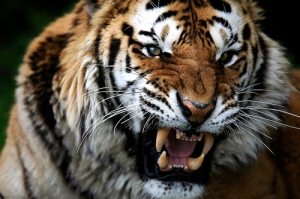
Surprisingly,
the tiger toes the line between threatening and pitiful. He is lame in
one foot, which is why he attacks cattle and humans instead of the more
sprightly deer, and on more than one occasion is a victim of his own
clumsiness. Nevertheless, he lays claim to Mowgli as he was the tiger’s
original target during an ambush. He is a constant shadow throughout the
first half of the book, even going so far as to manipulate some of the
younger wolves in the pack in the hope of their casting Mowgli out.
However, it turns out he is not the most threatening enemy Mowgli has to
face in his adventures.
It seems that Disney took away most of
the characters’ testosterone from the original book and gave it all to
Shere Khan, so that there is a clear and threatening villain and a clear
good vs. evil storyline. They also emphasise Mowgli’s awkwardness and
how he doesn’t seem to fit in with the other animals, to hammer home the
need for him to return to the man village. There does not appear to be
such a need in the book, as Mowgli is clearly at home and capable of
living in the jungle by himself. This brings us to how Mowgli ended up
in this situation to begin with.
The Set Up
Disney version
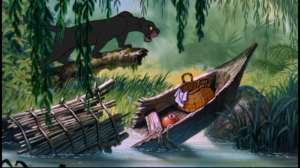
Pictured: GPS fail.
One morning, Bagheera the panther finds a
baby lying in a smashed up boat along the river. Rather than grabbing
an easy breakfast, he decides he should give it to someone to take care
of. Fortunately, he knows a family of wolves who have recently had cubs,
and thinks they would love to have an extra mouth to feed. He carries
the baby basket to their lair and leaves it outside for the mother and
father to find. There is barely any discussion involved as both parents
are still enamoured by babies, no matter what the species, and so they
readily accept Mowgli into their pack.

Bagheera
keeps a watchful eye over Mowgli as he grows up, and ten years later,
he realises the time will come when he will have to go back to the man
village – which begs the question why he didn’t take the baby there in
the first place. This turns into a reality after a meeting of the wolves
at Council Rock, where it’s established that Shere Khan, the tiger, has
returned to this part of the jungle, and has a hankering for human
blood. The wolves decide that they are no match for a tiger, and that
the best thing to do is take Mowgli from his family and everything he
knows and dump him in the man village where he’ll be safe. Bagheera
volunteers to take him, as he and Mowgli often went on walks together,
and so the next night the panther sets off with him. This is the last we
see of the wolf pack in the film.
Kipling version

The
book opens with Mother and Father Wolf snoozing, and being interrupted
by such things as the sound of Shere Khan burning his feet on a camp
fire. A human toddler suddenly appears in the grasses in front of their
lair, completely unafraid and apparently amused by Father Wolf’s face.
Mother Wolf allows him into the lair to feed from her, and it’s at this
point that Shere Khan comes crashing after and tries to grab the child.
The wolves lay claim to Mowgli, and Mother Wolf threatens the tiger and
says that one day Mowgli will slay him as he tried to slay the boy’s
parents. Shere Khan sneers and says that the other wolves would never
accept a human child into the pack.

When Mother and Father Wolf present their
children, foundling included, to the rest of the pack, there is a bit
of an issue as predicted. According to the Law, if there is question as
to a cub being accepted into the pack, two non-related animals must
vouch for it. Baloo the bear steps in and says he will teach the child
the Laws of the Jungle, and Bagheera the panther says he will vouch for
him too, and gives the pack a payment of a freshly killed bull in
exchange for allowing Mowgli to stay. This sways the pack in his favour,
and the oblivious toddler is accepted as a wolf, despite the complaints
of a handful of younger wolves and Shere Khan himself, who has been
prowling nearby. Akela the pack leader says this is a final decision,
and agrees that Mowgli will be useful to them in future.
Somehow he's even more orange than the tiger.
Disney’s version therefore sees Mowgli
raised by wolves from a baby, so the jungle really is all he knows. In
Kipling’s version, he is an older toddler whose parents are chased off
by Shere Khan, so there is a part of him that is aware of his human
heritage. Also, the wolf pack are unmoved by Shere Khan’s presence or
threats, and are able to protect the boy effectively. The film sees
Mowgli’s destiny as rejoining the man village as a result of this
threat, whereas the novel points more towards his destiny of killing
Shere Khan the tiger.
The Encounter With Kaa
Disney version

Disney’s
Mowgli encounters Kaa on two occasions. The first time is his first
night away from the wolf pack with Bagheera. The panther ingeniously
picked the one tree where Kaa was resting, and the python stuns and
prepares to eat Mowgli. Fortunately, Bagheera wakes up in time to give
him a wallop, but then pays the price by being hypnotised himself. By
this point Mowgli has recovered himself and kicks Kaa’s coils off the
end of the branch, making him flop to the ground. Bagheera is revived by
a smack around the chops, and he then reminds Mowgli how he couldn’t
possibly survive in the jungle alone.

On
the second occasion, Mowgli is grabbed by Kaa when he runs away from
Baloo and Bagheera on their second attempt to take him back to the man
village. Kaa puts him to sleep again, promising the only thing Mowgli is
likely to leave is his digestive tract, but is interrupted by Shere
Khan. While the tiger interrogates him, he is too intimidated to keep an
eye on Mowgli, who wakes up and kicks him off the branch again. Kaa
decides he wants nothing more to do with the man-cub and is last seen
slithering off into the distance with yet another knot in his tail.
Kipling Version

Other
than helping rescue Mowgli from the monkeys (I’ll get to this in a
moment), Kaa both helps him find some rare treasure and also protects
him from a formidable foe later in the book.
One night, he and Mowgli are relaxing and
cavorting in a rock pool, when Kaa says he has a great secret to tell
him. It turns out that somewhere in the Cold Lairs, there is a white
cobra that is guarding some buried treasure. He and Mowgli venture over
there, and find several kings’ ransoms in gold, silver, rubies and
jewellery, stacked up over the years. The white cobra then reveals that
in exchange for showing him the treasure, he must now take Mowgli’s
life, so that no other being knows where the goods are hidden.
Kaa is outraged that this was the cobra’s
intention from the beginning and threatens to attack him. Mowgli
reassures Kaa that he is able to take on the cobra himself and does so,
but the python remains aggressive towards the other snake and apologetic
to the man-cub for putting him in this situation.
Perhaps the biggest role Kaa plays is
when a pack of Indian hunting dogs known as dholes (rather than a-holes)
threatens the wolf pack. The pack is unmatchable in strength – even
Shere Khan retreated from them – and Mowgli is trying to think of ways
to get rid of them. Kaa carries Mowgli along the river and shows him a
ravine where the Little People live. Said Little People are vicious bees
which sting to death any intruders, so while Mowgli leads the dholes
here, Kaa protects him by holding him underwater where they can’t sting
him (he does let him up to breathe every so often though) and prevents
the current from carrying him away.
Disney’s Kaa is equal parts devious and
cowardly, as he is unable to stand up to Shere Khan. He also provides a
couple of laughs due to his impractical form and is pretty much helpless
on the ground. Kipling’s Kaa suffers no such indignity, and is not
intimidated by or afraid of anyone. He also supports Mowgli in two out
of three of the most important challenges he faces in the jungle. The
first of which is his abduction by the monkeys.
Monkey Business
Disney version

While
Mowgli is chilling with new found friend Baloo, monkeys dive down and
snatch him away. Baloo is given a beating of fruit and rocks, and the
monkeys carry the man-cub away to King Louie, who lives in the ancient
ruins.
As Bagheera and Baloo set off to rescue
him, Mowgli is musically greeted and interrogated by King Louie as to
the secret of making fire, and in exchange, the orangutan will let him
stay in the jungle. Mowgli confesses no such knowledge, but continues to
dance and eat bananas with the monkeys until his rescuers arrive.
Bagheera decides to sneak up on Mowgli and grab him, but this is
somewhat hindered by Baloo’s apparent penchant for dressing up as a
female ape and joining in the party.

Said
party ends as Baloo’s disguise suddenly falls off, and in the ensuing
chaos Bagheera manages to grab Mowgli and get away. King Louie ends up
trapped, holding up the collapsing remains of the ruins, and after
giving him a severe tickling in his armpits, Baloo follows suit as the
bricks and boulders crumble around them.
Kipling version
Instead of chilling with Baloo, Mowgli is
nursing his bruises after another beating. The man-cub then reveals
that he has been talking with the bandar-log, or Monkey People,
as they are the only ones who take pity on him when the bear beats him
up. Bagheera and Baloo are angry and shocked at this news, as the
lawless monkeys are forbidden to the other Jungle People, and they scold
Mowgli for associating with them.
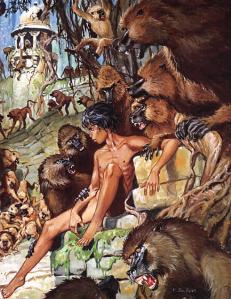
During
their afternoon nap, the monkeys come back and kidnap Mowgli, with the
intent of one day making him their leader, and whisk him away to their
home in the Cold Lairs. Instead of making fire, they want him to teach
them how to make huts to shelter from the wind, but like a group of
hyperactive children, they quickly get bored of this and decide to keep
Mowgli prisoner.
When Bagheera and Baloo hear of this news
they’re at a loss at what to do. The monkeys can be a formidable foe
due to their superior numbers, so no amount of cross-dressing or singing
is going to distract them. They instead seek out Kaa, as he is the only
one the monkeys are truly afraid of. The three friends arrive at the
Cold Lairs, and there is a vicious life-or-death fight between them and
the bandar-log. Kaa manages to free Mowgli using the weight of
his twenty-foot body to break down a wall, and he then hypnotises the
monkeys using a death dance. Unlike the film, Mowgli is the only one who
seems immune to this, and prods Baloo and Bagheera asking them why they
are so transfixed by Kaa wiggling about on the ground.
After the fight and once they are all
safe and sound, a battered and bruised Bagheera also has a turn at
beating up Mowgli, to punish him for getting involved with the monkeys
in the first place. Once he has smacked him around sufficiently, they
set off for home and say no more about it.
In the film, although Mowgli is initially
abducted against his will, he ends up having fun with the monkeys and
arguably getting what he wants – a pass to stay in the jungle forever.
However, Baloo and Bagheera still come and rescue him in the same way
they would if he were found playing with a group of petty thugs or
trouble makers. In Kipling’s novel Mowgli is clearly taken and held
against his will, and the battle is more brutal than amusing.
March of the Elephants
Disney version
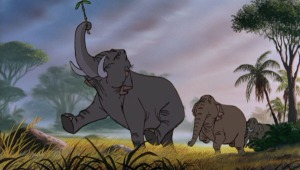
The
first morning after Mowgli leaves his pack, and a little while later
when he has run away again, we encounter Colonel Hathi and his herd of
elephants. They call themselves the Jungle Patrol, and march back and
forth singing but doing nothing in particular apart from felling trees
and unwittingly foiling Shere Khan’s attempts at hunting.
The Colonel is a traditional, pompous and
slightly doo-lally military elephant, and as a result doesn’t take too
kindly to Mowgli’s attempts at integrating with his herd. However, he is
potentially useful later as after some cajoling from his mate,
Winifred, and his son, he agrees to help Bagheera find the man-cub and
tells his patrol to keep a look out for him.
Kipling version
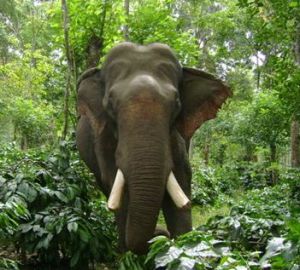
Hathi
is a wise old elephant and the recognised Master of the Jungle. He has
three sons who accompany him, and he watches over the Water Truce:
during the dry season, he makes sure there isn’t a blood-bath
free-for-all at the local watering hole. Even Shere Khan speaks politely
to him as he is aware of his status, and he is far from the doddery
military figure in Disney’s version.
He doesn’t have a Jungle Patrol, but he
does help Mowgli trash an entire man village in revenge. It’s not the
first time he has done this either – the previous time, many years ago,
he apparently returned from his rampage with blood on his tusks, but the
scent of human blood continues to haunt him as a result. This was
actually a secret, but Mowgli found out and therefore enlisted his help
attacking another village. From this point onwards, Mowgli is more
recognised as the Master of the Jungle instead of Hathi.
The elephants in the Disney film feel a
bit shoe-horned in, and are just there to give another example of Mowgli
trying to fit in with the animals and therefore stay in the jungle.
Hathi is a comedic and ridiculous figure here, but in the book he
maintains an air of grace and respect, and has great knowledge of the
jungle. He also helps Mowgli as soon as he is called upon, and doesn’t
need to be persuaded at all.
Mowgli vs. Shere Khan
Disney version

Stick vs. tiger. Next week, feather duster vs. elephant.
The second time Mowgli runs away from his
guardians, he comes across a group of mangy, completely un-Beatle-like
vultures living in a wasteland. As usual, they sing to him and welcome
him into their group as an honorary vulture, and, as usual, singing
distracts them from approaching danger: Shere Khan has finally tracked
down his man-cub.
Mowgli is literally unmoved by this and
won’t run from the tiger. This show of spirit impresses Shere Khan, who
is very sportsmanlike and decides to give Mowgli a fighting chance by
counting to ten before tearing him to shreds. Mowgli grabs a stick to
defend himself, but pretty much wets his pants when the tiger finally
strikes. Fortunately, Baloo has arrived just in time and grabs the big
cat’s tail so he misses, and a fight ensues. The vultures swoop down and
whisk Mowgli to safety, but Baloo is not so lucky – as well as a meaty
bite on the bum, he gets utterly mauled by the tiger and collapses,
dead.
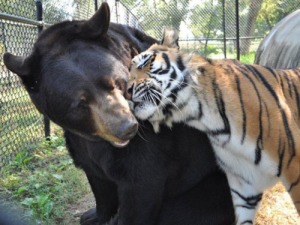
Joking! Then they make up and it’s all okay.
Actually, no, Shere Khan leaves Baloo in a
mess and goes for Mowgli, but the vultures mob him. Luckily, lightning
strikes at the right time for once and sets fire to one of the dead
trees. The vultures tell Mowgli this is the only thing “Old Stripes” is
afraid of, and so Mowgli ties a flaming branch to the tiger’s tail.
Shere Khan reacts in horror, and dashes off into the horizon, terrified.

The
tiger now vanquished, Mowgli rushes to Baloo’s side, but the big bear
now seems to be resting in peace. Bagheera gently nudges him away and
gives the bear a touching eulogy, during which Baloo comes to, with not a
scratch on him despite being mauled by a deadly tiger. Everything is
roses again, and now Shere Khan has gone for good, Mowgli is free to
stay in the jungle with his Papa Bear.
Kipling version
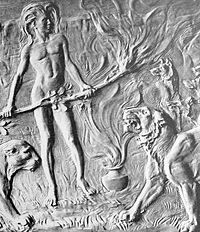
Mowgli: brave enough to hold a burning branch at crotch-level.
Kipling’s Mowgli faces Shere Khan not once, but twice. The first time is during an altercation at Council Rock.
Akela has grown old and weaker and one
night fails to catch a deer. This means that the pack leadership is now
open, and Shere Khan, who has been letting the younger wolves follow him
for scraps and teaching them how to snatch children, believes this is
his chance to drive Mowgli out of the pack and lay claim to him as his
kill. Bagheera sees this coming and tells Mowgli to steal the Red Flower
– fire – from the man village to protect himself. Mowgli steals a fire
pot, and keeps it alive by feeding it twigs while they wait for the next
meeting at Council Rock.
While at the meeting, Akela says that if
they make Mowgli return to the man village instead of driving him out
and into Shere Khan’s claws, he will not put up a fight when it comes to
battle him for leadership. Mowgli then takes a burning branch out of
the fire pot, and smacks Shere Khan around the head with it before
agreeing to return to the man village of his own accord. He swears that
the next time he comes back to Council Rock, he will drape the tiger’s
skin across it, and then heads down to the human settlement.
The second and final time he encounters
the tiger is a few months later when he is living as a cattle driver in
the man village. Gray Brother comes to see him occasionally, together
with the aged Akela, and they hatch a plan to get rid of the tiger once
and for all. Since Shere Khan is partial to human flesh, he doesn’t
stray too far from the village, and one afternoon he is lying up in a
narrow ravine near to the farmland.
With the help of the wolves and the herd of buffalo, Mowgli does this:

Uncle Scar would be proud.
Unable to climb up the steep walls to
escape, Shere Khan is crushed to death by the stampede, and Mowgli then
sits and skins him. Akela sits and watches him, and also pins down
Buldeo, a man from the village who has a very low opinion of Mowgli, and
who stumbled across the scene.
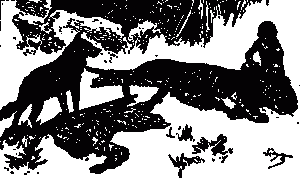
Mowgli
takes the skin back to Council Rock, and drapes it across the rock, as
he promised. His foe vanquished, he is able to live among the wolves
again.
Shere Khan in the film is humiliated in
battle by his fear of fire, and although he escapes alive, he will never
come back and bother anyone again. In the book, Shere Khan is not so
immediate or unstoppable a threat, and you could argue that he was all
bark and no bite – it’s Mowgli who instigates the violence towards him,
and kills him to fulfill his destiny and get rid of an irritation rather
than protect himself. Simply put, in the original novel, Shere Khan is
not the all-powerful, terrifying nemesis he is shown to be in the Disney
film.
The Man Village
Disney version
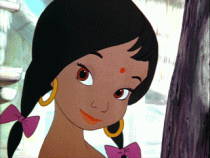
After
the fight with Shere Khan, Mowgli, Baloo and Bagheera seem to have
wandered unwittingly close to the man village. Mowgli suddenly hears
someone singing, and looking over he sees a young girl from the village
collecting water in a pot.
Despite Baloo’s warnings about women,
Mowgli edges closer for a better look, encouraged by Bagheera. The girl
looks up and acknowledges him – somehow missing the black panther and
the huge grey bear – and continues singing her song while making
suggestive eyes at him (but she’s about ten years old!). She then
“accidentally” drops the pot, and so Mowgli hurries up to grab it and
fill it with water again.

The
girl then entices him toward the village gates. Baloo calls for Mowgli
to come back, but the man-cub sort of shrugs and follows the girl into
the man village anyway, finally back where he (kind of) belongs. Their
work done, Baloo and Bagheera set off back to the jungle together.
Kipling version
Mowgli ends up in the man village on two
occasions (what is it with him doing everything twice?); once after his
first scrap with Shere Khan, about age ten, and again at the age of
seventeen, when he finally stays for good.
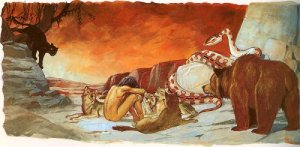
The
first time he goes and becomes a cattle driver, but when he first
arrives he can’t speak any human languages, and thinks the mud huts are
leopard traps. He therefore has great trouble adjusting to life among
humans, but he is helped by a kindly woman called Messua, who may or may
not be his real mother. She reveals Mowgli’s real name was Nathoo, and
helps look after him as he learns the human ways of life. In the
interim, he falls out with Buldeo, a respected hunter, and many are
suspicious of him for having been raised by wolves.
When Buldeo comes across Mowgli and Akela
when Shere Khan has been killed, Buldeo is freaked out and runs back to
tell the village that Mowgli is a devil child who can transform into a
wolf at will. This results in the locals threatening to burn Messua and
her husband at the stake for having such an evil child. Mowgli and
Bagheera hatch a plan to help them escape to a nearby white settlement,
and later Mowgli comes back to the village with Hathi and pretty much
raises it to the ground, or in their terms, “lets the jungle in”. He
then goes back to live with the wolf pack once more.

"Ugh, another wild weekend. Who did I marry this time?"
A few years later, after Akela has died,
Baloo has pretty much gone blind and Bagheera is older and more
decrepit, Mowgli comes to the conclusion that he must rejoin his fellow
men, as he is not an animal of the jungle. With great reluctance, he
bades his animal friends farewell, and goes to the next un-trashed man
village. Luckily, the first hut he comes across is where Messua and her
new son are now living, and Mowgli presumably stays with them and lives
out the rest of his days there.
Disney’s Mowgli is resistant to living in
the man village, as he has grown up with the wolf family and has no
other real home. He tries being an elephant, a bear and a monkey, but at
the end of the day, he must become a man, and only realises this once
he actually sees the man village and its (possible future) bounty.
Kipling’s Mowgli is the one that decides to go to the man village, and
accepts that this must be his fate, especially as he still has some
memories of his human heritage, and has a connection to his human mother
which makes the transition much easier – despite the issues of language
and behaviour, which the Disney version doesn’t touch upon.
Conclusion
Kipling’s
novel is more about Mowgli’s internal conflict as he tries to work out
who he is, rather than where he belongs. He is a skilled hunter and
tracker, and although he is recognised as Master of the Jungle, he is
still a man, and must therefore return to his own kind. He knows this
not only due to the differences between himself and his companions, but
because of his connection with his real parents and how he sees the
world. Going back to the man village is largely his decision, albeit a
sad one.
Disney’s film is about a boy going back
to where he belongs, and making sure everyone is in their rightful
place. The jungle can be as fun as it is dangerous, but try as he might,
Mowgli can’t fit in and adapt to it as he is a human, through and
through. As soon as he lays eyes on the man village, he suddenly can’t
think of being anywhere else, despite the wishes of some of the animals
that looked after him. Take that, nurture!
As well as downgrading the characters to
make them more caring and sensible (apart from Shere Kahn and Kaa),
Disney also saw fit to remove any references to the British Empire and
white settlements; made sure the local village was portrayed positively,
and of course made sure no endangered species were harmed during the
making of the film. While this is understandable, they do portray Mowgli
as a mischievous little scamp who should listen to his guardians and do
as he’s told, glossing over the fact that a) they took him away from
what he considered to be his real family without letting him say goodbye
and b) that they know better than he does and that children should
pretty much be seen and not heard. Conversely, Kipling’s Mowgli is
allowed to discover his own destiny by himself.
Both versions, however, show that being
naked and having cute animal friends is no substitute for warm clothes
and a real human family…
…most of the time, anyway.
Sources
1) The Jungle Book, 1967. Film. Directed by Wolfgang Reitherman, U.S.A. Walt Disney Pictures.
2) Kipling, Rudyard. The Jungle Books. Oxford University Press, U.K. 2008. ISBN: 978-0-19-953645-0
























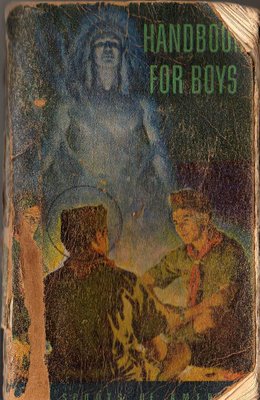
 The Christmas Scout Story
The Christmas Scout Story 










